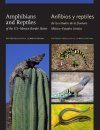![Amphibians and Reptiles of the US-Mexico Border States / Anfibios y Reptiles de Los Estados de la Frontera México-Estados Unidos Amphibians and Reptiles of the US-Mexico Border States / Anfibios y Reptiles de Los Estados de la Frontera México-Estados Unidos]()
Click to have a closer look
About this book
Customer reviews
Biography
Related titles
About this book
Language: Bilingual in English and Spanish
In the first bilingual work on the reptiles and amphibians of the US–Mexico border, top herpetologists come together to describe the herpetofauna of the states of this region, which includes more than 600 species of toads, frogs, salamanders, turtles, sea turtles, alligators, lizards, snakes, and sea snakes that are found along the almost 2,000-mile border between the two countries.
Each chapter is devoted to one state – four in the US (California, Arizona, New Mexico, and Texas) and six in Mexico (Baja California, Sonora, Chihuahua, Coahuila, Nuevo León, and Tamaulipas) – with text in both English and Spanish.
The chapters contain an introduction to the area, a review of the research, a sketch of the state's physiography, and a description of the species present as well as the pertinent conservation issues they face. A color photo gallery includes images of nearly all species.
Almost 40 percent of the featured native species are shared between the US and Mexico, reminding us that animals depend on the integrity of natural landscapes and proving the need for a comprehensive, bilingual reference to help lead a shared effort in the management and conservation of the borderlands.
Customer Reviews
Biography
Julio A. Lemos-Espinal is profesor titular of biology at the Facultad de Estudios Superiores Iztacala of the National Autonomous University of Mexico (UNAM) in Mexico City, USA. Widely published in both English and Spanish, Lemos-Espinal has three taxa of amphibians and reptiles named in his honor.
Flora / Fauna
By: Julio A Lemos-Espinal(Editor)
1056 pages, 78 plates with 600 colour photos, 6 b/w illustrations, 14 tables
"Amphibians and Reptiles of the US-Mexican Border States summarizes nearly all that is known about amphibians and reptiles of American and Mexican states that share a common border. What makes this compendium different from existing filed guides it that, in addition to providing distributional information, it contains a wealth of fascination information on the history of exploration in this region and the relationship between species composition and regional variation in geology and vegetation. The authors have invested entire careers working in portions of the region covered such that information about each species is based on first hand observations. Moreover, the authors are all highly respected scientists and naturalists. Ecologically and historically oriented herpetologists should have a copy of this book, and it should also be of interest to professional and amateur ecologists."
– Dr. Laurie J. Vitt, George Lynn Cross Research Professor, Curator Emeritus of Sam Noble Museum
"Having engaged in herpetological research in many areas on both sides and along both ends of our southern international border, I can verify the complexity of surveying the primary literature and using several state faunal compendia in support of such studies. Thus, publication of Amphibians and Reptiles of the US-Mexican Border States will help to circumvent those previous difficulties. The book will become an invaluable and requisite companion volume for those carrying out herpetological research along this international border. It will also educate by proxy those interested from afar in every aspect of the herpetofaunal transitions therein. The editor of this work is known for his extensive international collaborations, prodigious publication record, and status as the foremost author of books on Mexican state herpetofaunas in English and Spanish. The contributing authors of the new volume are also well known to have devoted much of their distinguished careers to various aspects of the biology of the border herpetofauna. This is a 'must have' book for all who share a passion for the world of amphibians and reptiles."
– James M. Walker, Professor of Biological Sciences, University of Arkansas



























![Belize Field Guide: Mammals, Amphibians and Reptiles [English / Spanish]](http://mediacdn.nhbs.com/jackets/jackets_resizer_medium/18/181132.jpg?height=150&width=63)














